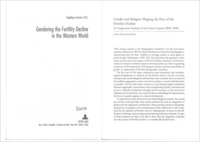Gender and religion shaping the pace of fertility decline
BHT
- Praz, Anne-Françoise University of Fribourg
- 2007
Published in:
- Janssens, Angelique (ed.), Gendering the Fertility Decline in the Western World. - 2007, p. 275-307
English
The first part of this paper emphasizes some theoretical and methodological developments in research on the fertility decline. On the one hand, scientists take methodological individualism more seriously: they are aware of the problems aggregation causes and seek to produce as much individual data as possible. On the other hand, studies try to go beyond simple correlations between supposedly causal factors and corresponding fertility outcomes and set out to identify mechanisms through which structures on the macro-level influence private decisions. As a result of these methodological improvements the focus on gender appears as a natural development.
To substantiate these theoretical and methodological remarks, the second part of this article provides some results produced by such an integration of gender into the explanatory mechanisms. Thanks to this gender perspective, we propose a new interpretation of the well-known Coale conditions for the adoption of fertility control. Subsequently, we focus on the difficulties in finding, constructing and interpreting indicators of gender. In spite of these problems, we hope to be able to show that the integration of gender into the analysis of fertility decline is a scientifically fruitful move. The data used were collected in the Swiss cantons of Vaud (VD – Protestant) and Fribourg (FR – Catholic), for the period 1880–1930. In each canton, two villages have been selected with respect to economic factors, in order to isolate the impact of institutional (religious) variables.
To substantiate these theoretical and methodological remarks, the second part of this article provides some results produced by such an integration of gender into the explanatory mechanisms. Thanks to this gender perspective, we propose a new interpretation of the well-known Coale conditions for the adoption of fertility control. Subsequently, we focus on the difficulties in finding, constructing and interpreting indicators of gender. In spite of these problems, we hope to be able to show that the integration of gender into the analysis of fertility decline is a scientifically fruitful move. The data used were collected in the Swiss cantons of Vaud (VD – Protestant) and Fribourg (FR – Catholic), for the period 1880–1930. In each canton, two villages have been selected with respect to economic factors, in order to isolate the impact of institutional (religious) variables.
- Faculty
- Faculté des lettres et des sciences humaines
- Department
- Département d'histoire contemporaine
- Language
-
- English
- License
- License undefined
- Open access status
- green
- Persistent URL
- https://folia.unifr.ch/unifr/documents/327766
Statistics
Document views: 55
File downloads:
- praz_2007_gender-religion-fertility-decline.pdf: 70
